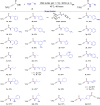β-Silyl alkynoates: Versatile reagents for biocompatible and selective amide bond formation
- PMID: 39292777
- PMCID: PMC11421574
- DOI: 10.1126/sciadv.adp7544
β-Silyl alkynoates: Versatile reagents for biocompatible and selective amide bond formation
Abstract
The study introduces a previously unidentified method for amide bond formation that addresses several limitations of conventional approaches. It uses the β-silyl alkynoate molecule, where the alkynyl group activates the ester for efficient amide formation, while the bulky TIPS (triisopropylsilane) group prevents unwanted 1,4-addition reactions. This approach exhibits high chemoselectivity for amines, making the method compatible with a wide range of substrates, including secondary amines, and targets the specific ε-amino group of lysine among the native amino ester's derivatives. It maintains stereochemistry during amide bond formation and TIPS group removal, allowing a versatile platform for postsynthesis modifications such as click reactions and peptide-drug conjugations. These advancements hold substantial promise for pharmaceutical development and peptide engineering, opening avenues for research applications.
Figures









Similar articles
-
The mechanism and structure-activity relationship of amide bond formation by silane derivatives: a computational study.Org Biomol Chem. 2019 Oct 23;17(41):9232-9242. doi: 10.1039/c9ob01605h. Org Biomol Chem. 2019. PMID: 31599296
-
Instability of Amide Bond with Trifluoroacetic Acid (20%): Synthesis, Conformational Analysis, and Mechanistic Insights into Cleavable Amide Bond Comprising β-Troponylhydrazino Acid.ACS Omega. 2020 Oct 1;5(40):26141-26152. doi: 10.1021/acsomega.0c03729. eCollection 2020 Oct 13. ACS Omega. 2020. PMID: 33073142 Free PMC article.
-
Fluoride Ion-Initiated Decarboxylation of Silyl Alkynoates to Alkynylsilanes.ACS Omega. 2021 May 3;6(19):12853-12857. doi: 10.1021/acsomega.1c01256. eCollection 2021 May 18. ACS Omega. 2021. PMID: 34056436 Free PMC article.
-
Harnessing and engineering amide bond forming ligases for the synthesis of amides.Curr Opin Chem Biol. 2020 Apr;55:77-85. doi: 10.1016/j.cbpa.2019.12.004. Epub 2020 Feb 12. Curr Opin Chem Biol. 2020. PMID: 32058241 Review.
-
Emerging methods in amide- and peptide-bond formation.Curr Opin Drug Discov Devel. 2006 Nov;9(6):765-75. Curr Opin Drug Discov Devel. 2006. PMID: 17117685 Review.
References
-
- Coin I., Beyermann M., Bienert M., Solid-phase peptide synthesis: From standard procedures to the synthesis of difficult sequences. Nat. Protoc. 2, 3247–3256 (2007). - PubMed
-
- Keller M., Blöchl E., Wächtershäuser G., Stetter K. O., Formation of amide bonds without a condensation agent and implications for origin of life. Nature 368, 836–838 (1994). - PubMed
-
- Pattabiraman V. R., Bode J. W., Rethinking amide bond synthesis. Nature 480, 471–479 (2011). - PubMed
LinkOut - more resources
Full Text Sources

